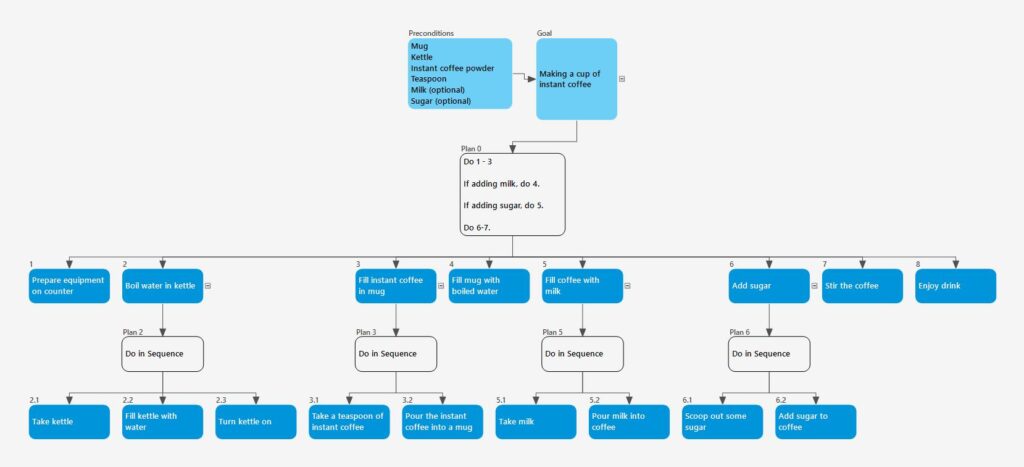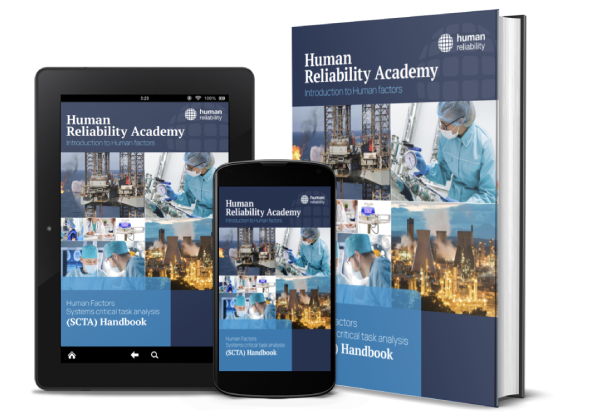Having participated as a facilitator in our in-house Human Factors Safety Critical Task Analysis (SCTA) course, as well as taking part in various SCTA workshops for around two years, I thought I would share my top 5 takeaways from doing and teaching HTAs.
But first…
What is Hierarchical Task Analysis (HTA)?
The HTA is a popular analysis technique used within the world of human factors. It works by breaking down a task into smaller components (also known as subtasks) and presenting the information in a manner similar to a tree diagram. Due to its structure and illustrative presentation, HTAs are a great tool for understanding a task and identifying areas to improve task performance.

Take Away 1: Gaining a deeper understanding of the task
One of the recurring themes from the course discussion and SCTA workshops is that people are often impressed by the number of steps involved even for a simple task.
While this can be overwhelming at the start, they have shared that breaking the task down into smaller components has helped them gain a clearer understanding of the realities of completing a task. This was mainly because the graphical presentation helped them visualise the complexities of the task and enabled them to digest the task in organised chunks/sections/branches of the HTA.
Additionally, due to its tree structure, it was easy to narrow down the focus and narrative of the SCTA discussions and workshops. So, even though creating a task using a HTA can look complicated, the elements of the HTA have many advantages which are helpful in establishing an understanding of the task and for starting a conversation.
Take Away 2: There is more to it than meets the eye
There was a client in pharmaceutical manufacturing who was experiencing several deviations regarding one of their processes. During the discussion, we suggested creating a HTA based on the procedures and the operator’s expertise.
Once the task was translated into a HTA, it was found that, in reality, there were a lot of simultaneous steps that required the operator’s attention. This suggested that there were other systemic issues that played as contributing factors to the deviation.
Following a productive workshop, we helped the client understand and identify several possible explanations of why the deviation occurred. This is also where the graphical presentation of this technique comes into play. By displaying the task as a tree diagram, it provides insight into some potential latent failures that play a contributing factor to critical events. As such, the HTA can bring value to a discussion by identifying potential solutions in the early prevention of a potentially critical event.
Take Away 3: Getting your Preconditions right
Before starting a task, it is crucial that you have the necessary prerequisites. Some instances of such prerequisites are having the correct equipment, people, conditions and so on. These are what we call Preconditions.
One thing that I have learned from my experience with HTAs is that Preconditions are a handy tool for helping individuals understand when a task should be performed and act as a ‘checklist’ for ensuring that the necessary equipment and other crucial components are present before beginning the task.
Moreover, it helps the user establish the task’s boundaries (i.e., when the task should start). In our course, we go through an exercise where the delegates are asked to create a HTA for changing a car tyre and during the group discussion, we go through many interesting points on why Preconditions are great for thinking about when to conduct a task. For example, someone raised that it is important to establish that the car is parked safely by the roadside before they can begin the task. Otherwise, the task could be conducted in a risky situation, which could lead to undesirable consequences.
Take Away 4: The importance of language
Another key take away is the importance of having appropriate language in HTAs, such as the correct vocabulary, clarity, and specificity.
For instance, in a road tanker offloading HTA, if a step only has the word “Monitor the offload”, it could carry various ambiguous meanings and may confuse the operator. Should the operator monitor the offload by checking the level in the storage vessel, or should they be checking the gas pressure, or should they be checking for leaks? On the other hand, if the step states “Monitor the offload by checking for leaks at the tanker’s connection point”, this helps the operator understand what checks need to be carried out at the appropriate location. Therefore, being clear and specific in the HTA can help people gain clarity of the correct action throughout the task.
Another thing that I found insightful was that certain words may mean different things across different cultural contexts. For example, during an SCTA course, a delegate highlighted that the words ‘ensure’, ‘check’, and ‘confirm’ vary in their meanings. While these words imply that a check is to be done, the delegate shared that ‘confirm’ involves some form of communication with another party, and that ‘ensure’ and ‘check’ do not have the same degree of impact. Therefore, it is valuable to be more conscious of how language could affect people’s understanding of critical actions and the value of using appropriate and suitable language when creating a HTA.
Take Away 5: HTA is a great training tool
My final takeaway is that the HTA works nicely as a tool for guiding people in the best way to carry out a task. Following all the points from above, the HTA can be a great tool for helping people understand the safest and most efficient way possible to perform a task. Through having clear and precise language, specific Preconditions, and a detailed description of the task, it can be easy to transfer all of this information to a training document. This also ensures that everyone is educated on the safest working practices possible and helps prevent and minimise the risk of an undesirable event.
To learn more about HTA, click here.
For more information about our SCTA course, click here.














